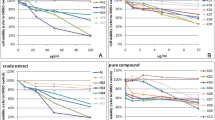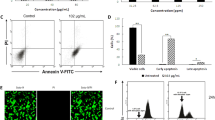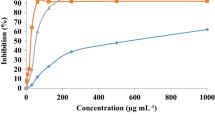Abstract
Background
Jisilhaebaekgyeji-Tang (JHG, Zhishi Xiebai Guizhi Tang) is a famous traditional herbal medicine described in the Geumgweyoryak (Jin Gui Yao Lue), an ancient Chinese medical text. JHG is composed of five medicinal herbs and is used to treat thoracic obstructions in China, Japan, and Korea. Although it has been reported the inhibitory effect of JHG against skin and lung cancers, there is a lack of reliable scientific evidence supporting its efficacy.
Objective
In the present study, we investigated the effects of JHG on human breast cancer cell lines and explored the underlying mechanisms. The anticancer effects of the JHG were evaluated in human breast cancer cell lines and human umbilical vein endothelial cells (HUVECs).
Results
An ethanol extract of JHG suppressed the growth of cells representing four subtypes of human breast cancer. In particular, JHG showed the greatest inhibitory effect against MCF-7 cells and was found to significantly reduce the mitochondrial membrane potential. Furthermore, the extract dose-dependently inhibited the expression of BCL-2, MCL-1, survivin, and procaspases-9 and -7 and induced nuclear condensation and fragmentation. In MCF-7 cells, the JHG extract inhibited the phosphorylation of the estrogen receptor alpha (ERα) and the activation of the mTOR and ERK pathways but enhanced the phosphorylation of p38 mitogen-activated protein kinase. In addition, the extract attenuated the hypoxia-inducible factor-1α/vascular endothelial growth factor signaling pathway under hypoxia-mimicking conditions and inhibited the metastatic ability of MCF-7 cells, including their migration and invasion activities, and the angiogenic properties of HUVECs.
Conclusion
The results suggest that the JHG extract exerts potent anticancer effects and that these effects may be due to the inhibition of ERα and the induction of intrinsic pathway-mediated apoptosis in MCF-7 cells.







Similar content being viewed by others
Abbreviations
- ANOVA:
-
Analysis of variance
- CAM:
-
Complementary and alternative medicine
- DAPI:
-
4,6-Diamidino-2-phenylindole
- DMEM:
-
Dulbecco’s modified eagle’s medium
- DMSO:
-
Dimethyl sulfoxide
- EGF:
-
Epidermal growth factor
- ELISA:
-
Enzyme-linked immunosorbent assay
- ERα:
-
Estrogen receptor alpha
- FBS:
-
Fetal bovine serum
- HIF-1α:
-
Hypoxia-inducible factor-1α
- HUVECs:
-
Human umbilical vein endothelial cells
- JHG:
-
Jisilhaebaekgyeji-Tang
- MAPK:
-
Mitogen-activated protein kinases
- MTT:
-
3-(4,5-Dimethylthiazol-2-yl)-2,5-diphenyl-tetrazolium bromide
- PBS:
-
Phosphate-buffered saline
- PBST:
-
PBS containing tween 20
- RPMI:
-
Roswell Park Memorial Institute media
- SD:
-
Standard deviations
- VEGF:
-
Vascular endothelial growth factor
References
Alayev A et al (2016) mTORC1 directly phosphorylates and activates ERalpha upon estrogen stimulation. Oncogene 35(27):3535–3543
Baracca A, Sgarbi G, Solaini G, Lenaz G (2003) Rhodamine 123 as a probe of mitochondrial membrane potential: evaluation of proton flux through F(0) during ATP synthesis. Biochim Biophys Acta 1606(1–3):137–146
Basu P, Maier C (2018) Phytoestrogens and breast cancer: in vitro anticancer activities of isoflavones, lignans, coumestans, stilbenes and their analogs and derivatives. Biomed Pharmacother 107:1648–1666
Berry WL, Shin S, Lightfoot SA, Janknecht R (2012) Oncogenic features of the JMJD2A histone demethylase in breast cancer. Int J Oncol 41(5):1701–1706
Bharti S, Rani N, Krishnamurthy B, Arya DS (2014) Preclinical evidence for the pharmacological actions of naringin: a review. Planta Med 80(6):437–451
Bray F et al (2018) Global cancer statistics 2018: GLOBOCAN estimates of incidence and mortality worldwide for 36 cancers in 185 countries. CA Cancer J Clin 68(6):394–424
Brenton JD, Carey LA, Ahmed AA, Caldas C (2005) Molecular classification and molecular forecasting of breast cancer: ready for clinical application? J Clin Oncol 23(29):7350–7360
Buteau-Lozano H et al (2002) Transcriptional regulation of vascular endothelial growth factor by estradiol and tamoxifen in breast cancer cells: a complex interplay between estrogen receptors alpha and beta. Cancer Res 62(17):4977–4984
Camargo CA, Gomes-Marcondes MC, Wutzki NC, Aoyama H (2012) Naringin inhibits tumor growth and reduces interleukin-6 and tumor necrosis factor alpha levels in rats with Walker 256 carcinosarcoma. Anticancer Res 32(1):129–133
Cao H, Chen SW, Wang MW, Wang NL (2001) Comparison on pharmacodynamics effects between different extracts of Fructus Trichosanthis and Bulbus Allii Macrostemi. Chin Tradit Patent Med 23(11):814–816
Cha MR, Yoon MY, Son ES, Park HR (2009) Selective cytotoxicity of Ponciri fructus against glucose-deprived PANC-1 human pancreatic cancer cells via blocking activation of GRP78. Biosci Biotechnol Biochem 73(10):2167–2171
Chan LW et al (2008) Antimicrobial and antioxidant activities of cortex Magnoliae officinalis and some other medicinal plants commonly used in South-East Asia. Chin Med 3:15
Choi DY, Kim JK, Lyeom YH (2004) Jin Gui Yao Lue. Dongguk university Press, Seoul, Korea
Comsa S, Cimpean AM, Raica M (2015) The story of MCF-7 breast cancer cell line: 40 years of experience in research. Anticancer Res 35(6):3147–3154
Cronin PA, Wang JH, Redmond HP (2010) Hypoxia increases the metastatic ability of breast cancer cells via upregulation of CXCR4. BMC Cancer 10:225
de Leeuw R, Neefjes J, Michalides R (2011) A role for estrogen receptor phosphorylation in the resistance to tamoxifen. Int J Breast Cancer 2011:232435
Duzgun SA et al (2017) Differential effects of p38 MAP kinase inhibitors SB203580 and SB202190 on growth and migration of human MDA-MB-231 cancer cell line. Cytotechnology 69(4):711–724
Fan W, Chang J, Fu P (2015) Endocrine therapy resistance in breast cancer: current status, possible mechanisms and overcoming strategies. Future Med Chem 7(12):1511–1519
Gilkes DM (2016) Implications of hypoxia in breast cancer metastasis to bone. Int J Mol Sci 17:10
Jang SH et al (2003) Protective effects of Jisilhaebaekgyeji-tang and constituents extract on cultured rat myocardial cell treated by XO/HX. J Physiol and Pathol Korean Med 17(4):952–957
Jang SB, Baek SE, Choi KH, Yoo JE (2016) The analysis of the experimental research trend of efficacy of Gyejibokryeong-hwan. J Korean Obstet Gynecol 29(2):99–112
Jin X, Mu P (2015) Targeting breast cancer metastasis. Breast Cancer (auckl) 9(Suppl 1):23–34
Jung KW, Won YJ, Kong HJ, Lee ES (2018) Cancer statistics in Korea: incidence, mortality, survival, and prevalence in 2015. Cancer Res Treat 50(2):303–316
Kim DH, Bae EA, Han MJ (1999) Anti-helicobacter pylori activity of the metabolites of poncirin from Poncirus trifoliata by human intestinal bacteria. Biol Pharm Bull 22(4):422–424
Klinge CM (2001) Estrogen receptor interaction with estrogen response elements. Nucleic Acids Res 29(14):2905–2919
Korean Breast Cancer Society (2020) Breast cancer facts and figures 2020. Korean Breast Cancer Society, Seoul
Koul HK, Pal M, Koul S (2013) Role of p38 MAP kinase signal transduction in solid tumors. Genes Cancer 4(9–10):342–359
Lannigan DA (2003) Estrogen receptor phosphorylation. Steroids 68(1):1–9
Lee EO et al (2006) The methylene chloride fraction of Trichosanthis Fructus induces apoptosis in U937 cells through the mitochondrial pathway. Biol Pharm Bull 29(1):21–25
Lee YK et al (2009) Protective effect of the ethanol extract of Magnolia officinalis and 4-O-methylhonokiol on scopolamine-induced memory impairment and the inhibition of acetylcholinesterase activity. J Nat Med 63(3):274–282
Lee JH et al (2017) Anticancer effects of a Korean herbal medicine formula (H9) via AMPK and HER2-PI3K/Akt signaling in breast cancer cells. Phytother Res 31(11):1765–1775
Liu Y et al (2008) Effects of Bulbus allii macrostemi on clinical outcomes and oxidized low-density lipoprotein and plasminogen in unstable angina/non-ST-segment elevation myocardial infarction patients. Phytother Res 22(11):1539–1543
Liu Y et al (2013) The natural compound magnolol inhibits invasion and exhibits potential in human breast cancer therapy. Sci Rep 3:3098
Liu J et al (2018) Nobiletin inhibits breast cancer via p38 mitogen-activated protein kinase nuclear transcription factor-kappaB, and nuclear factor erythroid 2-related factor 2 pathways in MCF-7 cells. Food Nutr Res. https://doi.org/10.29219/fnr.v62.1323
Liu J et al (2018a) Alantolactone induces apoptosis and suppresses migration in MCF7 human breast cancer cells via the p38 MAPK, NFkappaB and Nrf2 signaling pathways. Int J Mol Med 42(4):1847–1856
Liu J et al (2020) The traditional uses, phytochemistry, pharmacology and toxicology of Cinnamomi ramulus: a review. J Pharm Pharmacol 72(3):319–342
Mendoza RA et al (2011) Tumorigenicity of MCF-7 human breast cancer cells lacking the p38alpha mitogen-activated protein kinase. J Endocrinol 208(1):11–19
Okuyama T (1997) Cancer chemoprevention with everyday food, traditional Japanese food, and traditional folk medicines. In: Ohigashi H, Osawa T, Terao J, Watanabe S, Yoshikawa T (eds) Food factors for cancer prevention. Springer, Japan, Tokyo, pp 270–275
Oladipupo S et al (2011) VEGF is essential for hypoxia-inducible factor-mediated neovascularization but dispensable for endothelial sprouting. Proc Natl Acad Sci U S A 108(32):13264–13269
Park EJ et al (2009) Down-regulation of c-Src/EGFR-mediated signaling activation is involved in the honokiol-induced cell cycle arrest and apoptosis in MDA-MB-231 human breast cancer cells. Cancer Lett 277(2):133–140
Partridge AH, Burstein HJ, Winer EP (2001) Side effects of chemotherapy and combined chemohormonal therapy in women with early-stage breast cancer. J Natl Cancer Inst Monogr 30:135–142
Raha S et al (2015) Naringin induces autophagy-mediated growth inhibition by downregulating the PI3K/Akt/mTOR cascade via activation of MAPK pathways in AGS cancer cells. Int J Oncol 47(3):1061–1069
Rajabi M, Mousa SA (2017) The role of angiogenesis in cancer treatment. Biomedicines 5:2
Rees RW et al (2000) Prevalence of complementary therapy use by women with breast cancer. A population-based survey. Eur J Cancer 36(11):1359–1364
Shim KS et al (2015) Water extract of Magnolia officinalis cortex inhibits osteoclastogenesis and bone resorption by downregulation of nuclear factor of activated T cells cytoplasmic 1. Integr Med Res 4(2):102–111
So FV et al (1996) Inhibition of human breast cancer cell proliferation and delay of mammary tumorigenesis by flavonoids and citrus juices. Nutr Cancer 26(2):167–181
Subramani R, Lakshmanaswamy R (2017) Complementary and alternative medicine and breast cancer. Prog Mol Biol Transl Sci 151:231–274
Tang Y et al (2018) Herbal medicine (zhishi xiebai guizhi decoction) for unstable angina: protocol for a systematic review and meta-analysis. Medicine (baltimore) 97(52):e13965
Ward RD, Weigel NL (2009) Steroid receptor phosphorylation: assigning function to site-specific phosphorylation. BioFactors 35(6):528–536
Yang J et al (2015) Estrogen receptor-alpha directly regulates the hypoxia-inducible factor 1 pathway associated with antiestrogen response in breast cancer. Proc Natl Acad Sci U S A 112(49):15172–15177
Yu X et al (2018) Trichosanthis Fructus: botany, traditional uses, phytochemistry and pharmacology. J Ethnopharmacol 224:177–194
Zhou Y et al (2013) Magnolol induces apoptosis in MCF-7 human breast cancer cells through G2/M phase arrest and caspase-independent pathway. Pharmazie 68(9):755–762
Zhu L et al (2016) Chinese herbal medicine as an adjunctive therapy for breast cancer: a systematic review and meta-analysis. Evid Based Complement Alternat Med 2016:9469276
Acknowledgements
This research was supported by a grant of the Korea Health Technology R&D Project through the Korea Health Industry Development Institute (KHIDI), funded by the Ministry of Health and Welfare, Republic of Korea (grant number: HF21C0129).
Author information
Authors and Affiliations
Contributions
SDP and JHL were responsible for the study design, funding, and supervision. JHL and SKJ participated in the experiments and wrote the manuscript. SMP, JYA, OHK, YWK, and KIP performed the experiments and statistical analysis. All the authors participated in manuscript preparation and approved the final version of the manuscript.
Corresponding authors
Ethics declarations
Conflict of interest
Sang Kyu Jeon declares that he has no conflict of interest. Su Mi Park declares that she has no conflict of interest. Jung Yun Ahn declares that she has no conflict of interest. Ok Hyeon Kim declares that she has no conflict of interest. Young Woo Kim declares that he has no conflict of interest. Kwang-Il Park declares that he has no conflict of interest. Sun-Dong Park declares that he has no conflict of interest. Ju-Hee Lee declares that she has no conflict of interest.
Ethical approval
This article does not contain any studies with human participants or animals performed by any of the authors.
Additional information
Publisher's Note
Springer Nature remains neutral with regard to jurisdictional claims in published maps and institutional affiliations.
Rights and permissions
About this article
Cite this article
Jeon, S.K., Park, S.M., Ahn, J.Y. et al. Anticancer activity of herbal formula Jisilhaebaekgyeji-Tang against human breast cancer cells and its mechanism. Mol. Cell. Toxicol. 19, 437–451 (2023). https://doi.org/10.1007/s13273-022-00271-9
Accepted:
Published:
Issue Date:
DOI: https://doi.org/10.1007/s13273-022-00271-9




